Human Resource Management Report: Deloitte's HRM Practices Analysis
VerifiedAdded on 2022/12/28
|20
|5711
|1
Report
AI Summary
This report provides a comprehensive analysis of Human Resource Management (HRM) practices within Deloitte. It begins with an introduction to HRM, defining its purpose and functions, particularly in workforce planning and resourcing. The report examines recruitment and selection approaches, evaluating their strengths and weaknesses. It then explores various HRM practices, such as employee benefits, positive work environment, and revised employee policies, assessing their effectiveness in raising organizational profit and productivity. The report further analyzes the importance of employee relations and the impact of employment legislation on HRM decision-making. It illustrates the application of specific HRM practices in a work-related context, providing a rationale for their implementation. The report uses Deloitte as a case study, offering specific examples to support evaluations and analyses throughout. Key areas covered include recruitment, selection, employee relations, training and development, and the impact of HRM on overall organizational success. The document concludes with a summary of findings and a list of references.
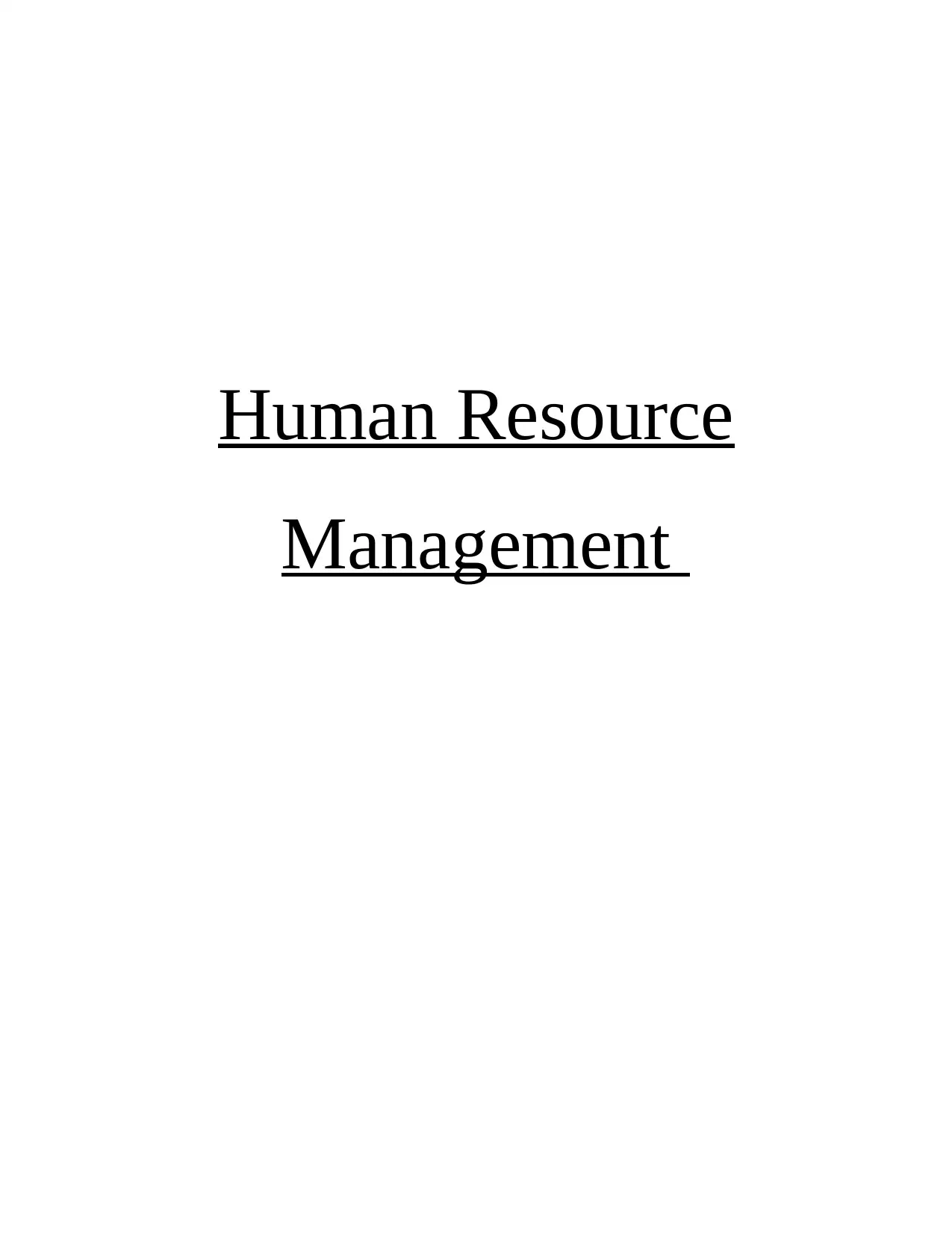
Human Resource
Management
Management
Paraphrase This Document
Need a fresh take? Get an instant paraphrase of this document with our AI Paraphraser
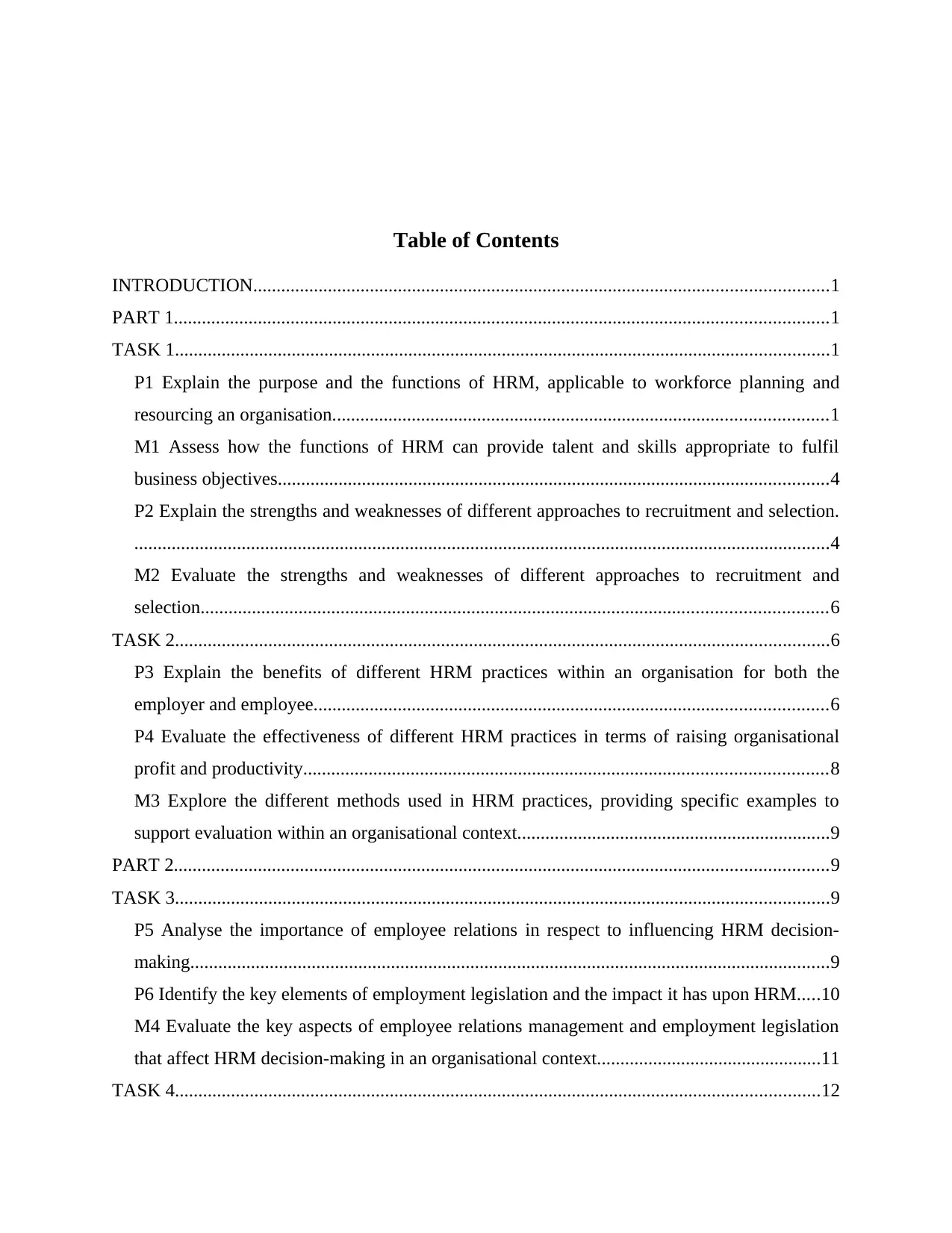
Table of Contents
INTRODUCTION...........................................................................................................................1
PART 1............................................................................................................................................1
TASK 1............................................................................................................................................1
P1 Explain the purpose and the functions of HRM, applicable to workforce planning and
resourcing an organisation..........................................................................................................1
M1 Assess how the functions of HRM can provide talent and skills appropriate to fulfil
business objectives......................................................................................................................4
P2 Explain the strengths and weaknesses of different approaches to recruitment and selection.
.....................................................................................................................................................4
M2 Evaluate the strengths and weaknesses of different approaches to recruitment and
selection......................................................................................................................................6
TASK 2............................................................................................................................................6
P3 Explain the benefits of different HRM practices within an organisation for both the
employer and employee..............................................................................................................6
P4 Evaluate the effectiveness of different HRM practices in terms of raising organisational
profit and productivity................................................................................................................8
M3 Explore the different methods used in HRM practices, providing specific examples to
support evaluation within an organisational context...................................................................9
PART 2............................................................................................................................................9
TASK 3............................................................................................................................................9
P5 Analyse the importance of employee relations in respect to influencing HRM decision-
making.........................................................................................................................................9
P6 Identify the key elements of employment legislation and the impact it has upon HRM.....10
M4 Evaluate the key aspects of employee relations management and employment legislation
that affect HRM decision-making in an organisational context................................................11
TASK 4..........................................................................................................................................12
INTRODUCTION...........................................................................................................................1
PART 1............................................................................................................................................1
TASK 1............................................................................................................................................1
P1 Explain the purpose and the functions of HRM, applicable to workforce planning and
resourcing an organisation..........................................................................................................1
M1 Assess how the functions of HRM can provide talent and skills appropriate to fulfil
business objectives......................................................................................................................4
P2 Explain the strengths and weaknesses of different approaches to recruitment and selection.
.....................................................................................................................................................4
M2 Evaluate the strengths and weaknesses of different approaches to recruitment and
selection......................................................................................................................................6
TASK 2............................................................................................................................................6
P3 Explain the benefits of different HRM practices within an organisation for both the
employer and employee..............................................................................................................6
P4 Evaluate the effectiveness of different HRM practices in terms of raising organisational
profit and productivity................................................................................................................8
M3 Explore the different methods used in HRM practices, providing specific examples to
support evaluation within an organisational context...................................................................9
PART 2............................................................................................................................................9
TASK 3............................................................................................................................................9
P5 Analyse the importance of employee relations in respect to influencing HRM decision-
making.........................................................................................................................................9
P6 Identify the key elements of employment legislation and the impact it has upon HRM.....10
M4 Evaluate the key aspects of employee relations management and employment legislation
that affect HRM decision-making in an organisational context................................................11
TASK 4..........................................................................................................................................12
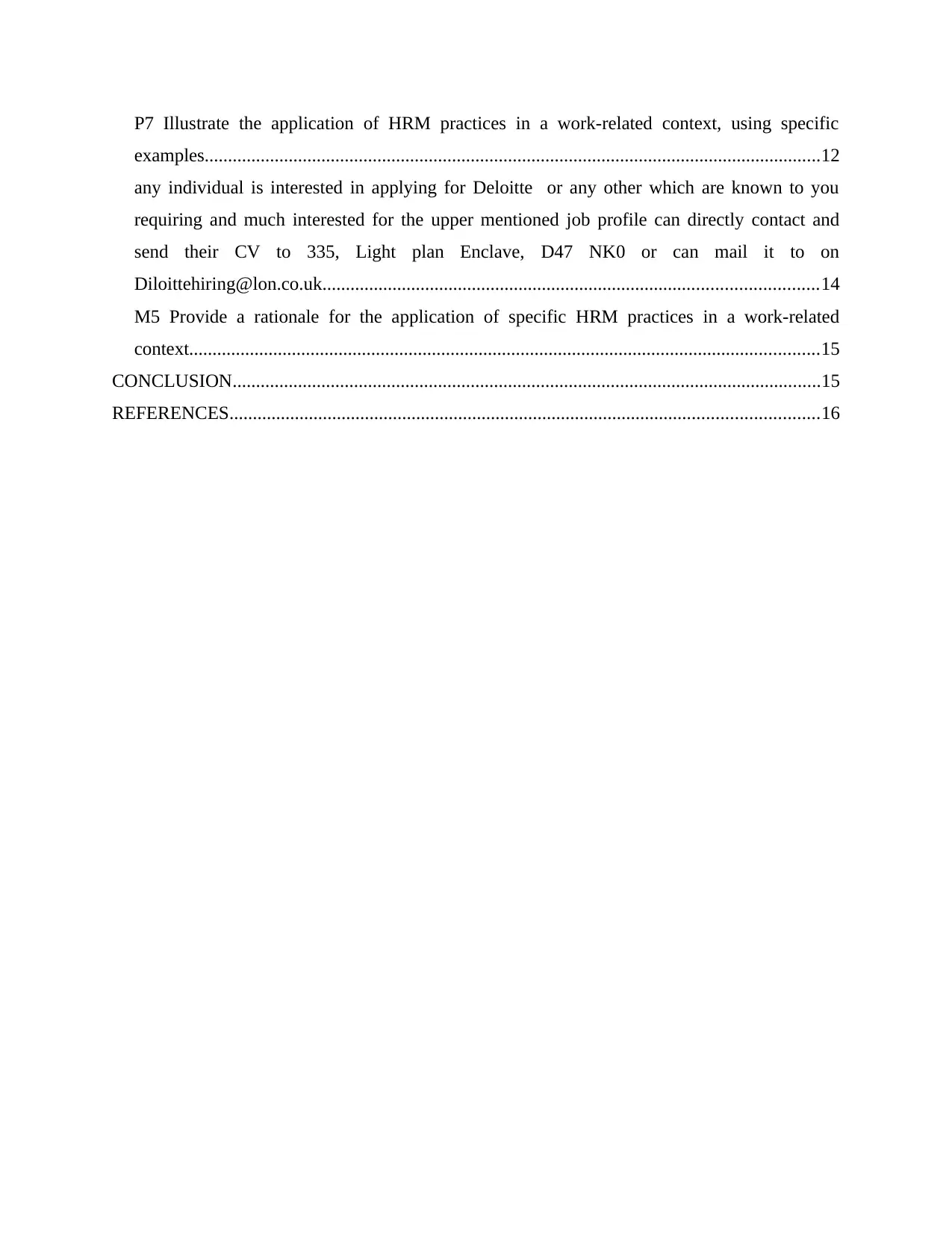
P7 Illustrate the application of HRM practices in a work-related context, using specific
examples....................................................................................................................................12
any individual is interested in applying for Deloitte or any other which are known to you
requiring and much interested for the upper mentioned job profile can directly contact and
send their CV to 335, Light plan Enclave, D47 NK0 or can mail it to on
Diloittehiring@lon.co.uk..........................................................................................................14
M5 Provide a rationale for the application of specific HRM practices in a work-related
context.......................................................................................................................................15
CONCLUSION..............................................................................................................................15
REFERENCES..............................................................................................................................16
examples....................................................................................................................................12
any individual is interested in applying for Deloitte or any other which are known to you
requiring and much interested for the upper mentioned job profile can directly contact and
send their CV to 335, Light plan Enclave, D47 NK0 or can mail it to on
Diloittehiring@lon.co.uk..........................................................................................................14
M5 Provide a rationale for the application of specific HRM practices in a work-related
context.......................................................................................................................................15
CONCLUSION..............................................................................................................................15
REFERENCES..............................................................................................................................16
⊘ This is a preview!⊘
Do you want full access?
Subscribe today to unlock all pages.

Trusted by 1+ million students worldwide
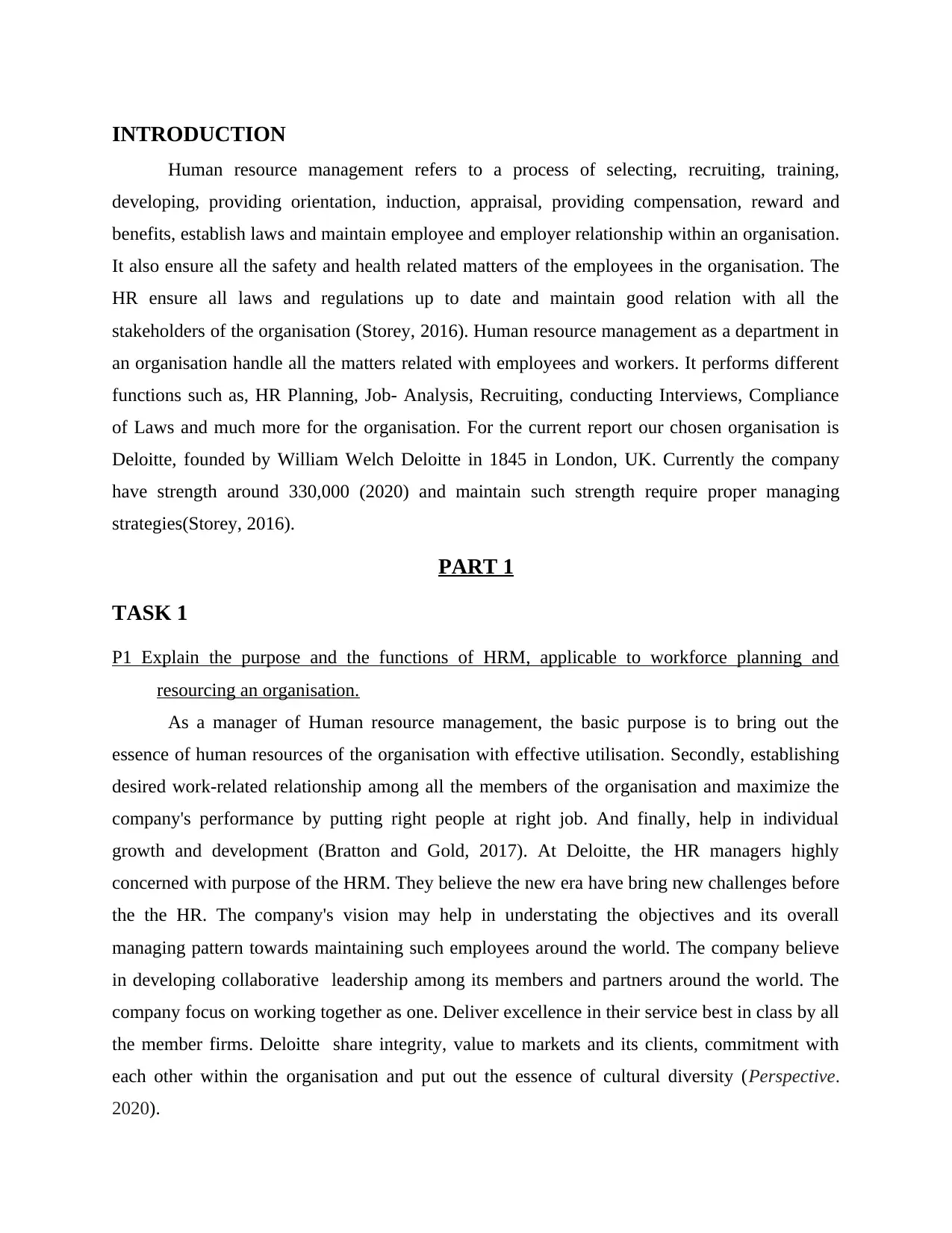
INTRODUCTION
Human resource management refers to a process of selecting, recruiting, training,
developing, providing orientation, induction, appraisal, providing compensation, reward and
benefits, establish laws and maintain employee and employer relationship within an organisation.
It also ensure all the safety and health related matters of the employees in the organisation. The
HR ensure all laws and regulations up to date and maintain good relation with all the
stakeholders of the organisation (Storey, 2016). Human resource management as a department in
an organisation handle all the matters related with employees and workers. It performs different
functions such as, HR Planning, Job- Analysis, Recruiting, conducting Interviews, Compliance
of Laws and much more for the organisation. For the current report our chosen organisation is
Deloitte, founded by William Welch Deloitte in 1845 in London, UK. Currently the company
have strength around 330,000 (2020) and maintain such strength require proper managing
strategies(Storey, 2016).
PART 1
TASK 1
P1 Explain the purpose and the functions of HRM, applicable to workforce planning and
resourcing an organisation.
As a manager of Human resource management, the basic purpose is to bring out the
essence of human resources of the organisation with effective utilisation. Secondly, establishing
desired work-related relationship among all the members of the organisation and maximize the
company's performance by putting right people at right job. And finally, help in individual
growth and development (Bratton and Gold, 2017). At Deloitte, the HR managers highly
concerned with purpose of the HRM. They believe the new era have bring new challenges before
the the HR. The company's vision may help in understating the objectives and its overall
managing pattern towards maintaining such employees around the world. The company believe
in developing collaborative leadership among its members and partners around the world. The
company focus on working together as one. Deliver excellence in their service best in class by all
the member firms. Deloitte share integrity, value to markets and its clients, commitment with
each other within the organisation and put out the essence of cultural diversity (Perspective.
2020).
Human resource management refers to a process of selecting, recruiting, training,
developing, providing orientation, induction, appraisal, providing compensation, reward and
benefits, establish laws and maintain employee and employer relationship within an organisation.
It also ensure all the safety and health related matters of the employees in the organisation. The
HR ensure all laws and regulations up to date and maintain good relation with all the
stakeholders of the organisation (Storey, 2016). Human resource management as a department in
an organisation handle all the matters related with employees and workers. It performs different
functions such as, HR Planning, Job- Analysis, Recruiting, conducting Interviews, Compliance
of Laws and much more for the organisation. For the current report our chosen organisation is
Deloitte, founded by William Welch Deloitte in 1845 in London, UK. Currently the company
have strength around 330,000 (2020) and maintain such strength require proper managing
strategies(Storey, 2016).
PART 1
TASK 1
P1 Explain the purpose and the functions of HRM, applicable to workforce planning and
resourcing an organisation.
As a manager of Human resource management, the basic purpose is to bring out the
essence of human resources of the organisation with effective utilisation. Secondly, establishing
desired work-related relationship among all the members of the organisation and maximize the
company's performance by putting right people at right job. And finally, help in individual
growth and development (Bratton and Gold, 2017). At Deloitte, the HR managers highly
concerned with purpose of the HRM. They believe the new era have bring new challenges before
the the HR. The company's vision may help in understating the objectives and its overall
managing pattern towards maintaining such employees around the world. The company believe
in developing collaborative leadership among its members and partners around the world. The
company focus on working together as one. Deliver excellence in their service best in class by all
the member firms. Deloitte share integrity, value to markets and its clients, commitment with
each other within the organisation and put out the essence of cultural diversity (Perspective.
2020).
Paraphrase This Document
Need a fresh take? Get an instant paraphrase of this document with our AI Paraphraser
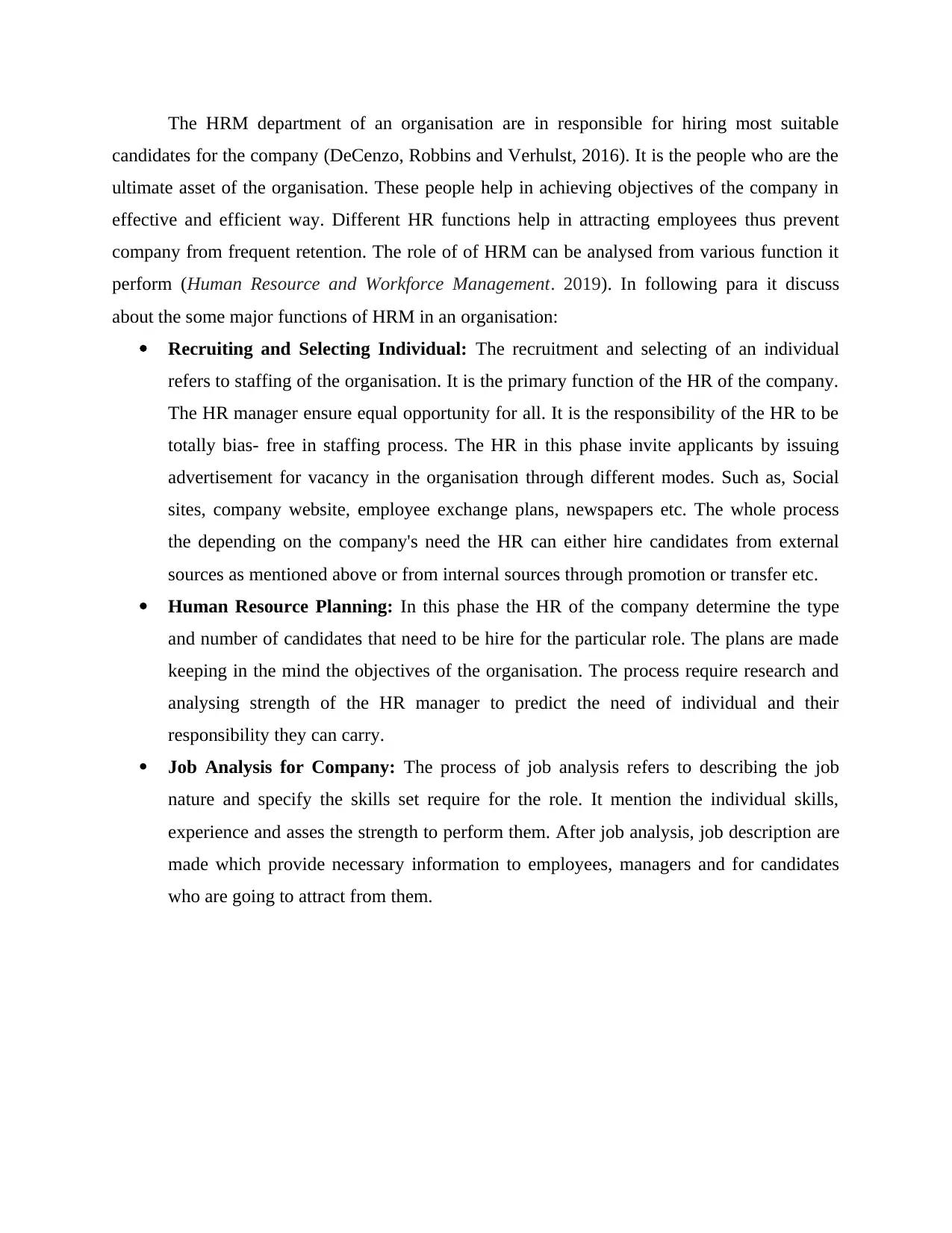
The HRM department of an organisation are in responsible for hiring most suitable
candidates for the company (DeCenzo, Robbins and Verhulst, 2016). It is the people who are the
ultimate asset of the organisation. These people help in achieving objectives of the company in
effective and efficient way. Different HR functions help in attracting employees thus prevent
company from frequent retention. The role of of HRM can be analysed from various function it
perform (Human Resource and Workforce Management. 2019). In following para it discuss
about the some major functions of HRM in an organisation:
Recruiting and Selecting Individual: The recruitment and selecting of an individual
refers to staffing of the organisation. It is the primary function of the HR of the company.
The HR manager ensure equal opportunity for all. It is the responsibility of the HR to be
totally bias- free in staffing process. The HR in this phase invite applicants by issuing
advertisement for vacancy in the organisation through different modes. Such as, Social
sites, company website, employee exchange plans, newspapers etc. The whole process
the depending on the company's need the HR can either hire candidates from external
sources as mentioned above or from internal sources through promotion or transfer etc.
Human Resource Planning: In this phase the HR of the company determine the type
and number of candidates that need to be hire for the particular role. The plans are made
keeping in the mind the objectives of the organisation. The process require research and
analysing strength of the HR manager to predict the need of individual and their
responsibility they can carry.
Job Analysis for Company: The process of job analysis refers to describing the job
nature and specify the skills set require for the role. It mention the individual skills,
experience and asses the strength to perform them. After job analysis, job description are
made which provide necessary information to employees, managers and for candidates
who are going to attract from them.
candidates for the company (DeCenzo, Robbins and Verhulst, 2016). It is the people who are the
ultimate asset of the organisation. These people help in achieving objectives of the company in
effective and efficient way. Different HR functions help in attracting employees thus prevent
company from frequent retention. The role of of HRM can be analysed from various function it
perform (Human Resource and Workforce Management. 2019). In following para it discuss
about the some major functions of HRM in an organisation:
Recruiting and Selecting Individual: The recruitment and selecting of an individual
refers to staffing of the organisation. It is the primary function of the HR of the company.
The HR manager ensure equal opportunity for all. It is the responsibility of the HR to be
totally bias- free in staffing process. The HR in this phase invite applicants by issuing
advertisement for vacancy in the organisation through different modes. Such as, Social
sites, company website, employee exchange plans, newspapers etc. The whole process
the depending on the company's need the HR can either hire candidates from external
sources as mentioned above or from internal sources through promotion or transfer etc.
Human Resource Planning: In this phase the HR of the company determine the type
and number of candidates that need to be hire for the particular role. The plans are made
keeping in the mind the objectives of the organisation. The process require research and
analysing strength of the HR manager to predict the need of individual and their
responsibility they can carry.
Job Analysis for Company: The process of job analysis refers to describing the job
nature and specify the skills set require for the role. It mention the individual skills,
experience and asses the strength to perform them. After job analysis, job description are
made which provide necessary information to employees, managers and for candidates
who are going to attract from them.
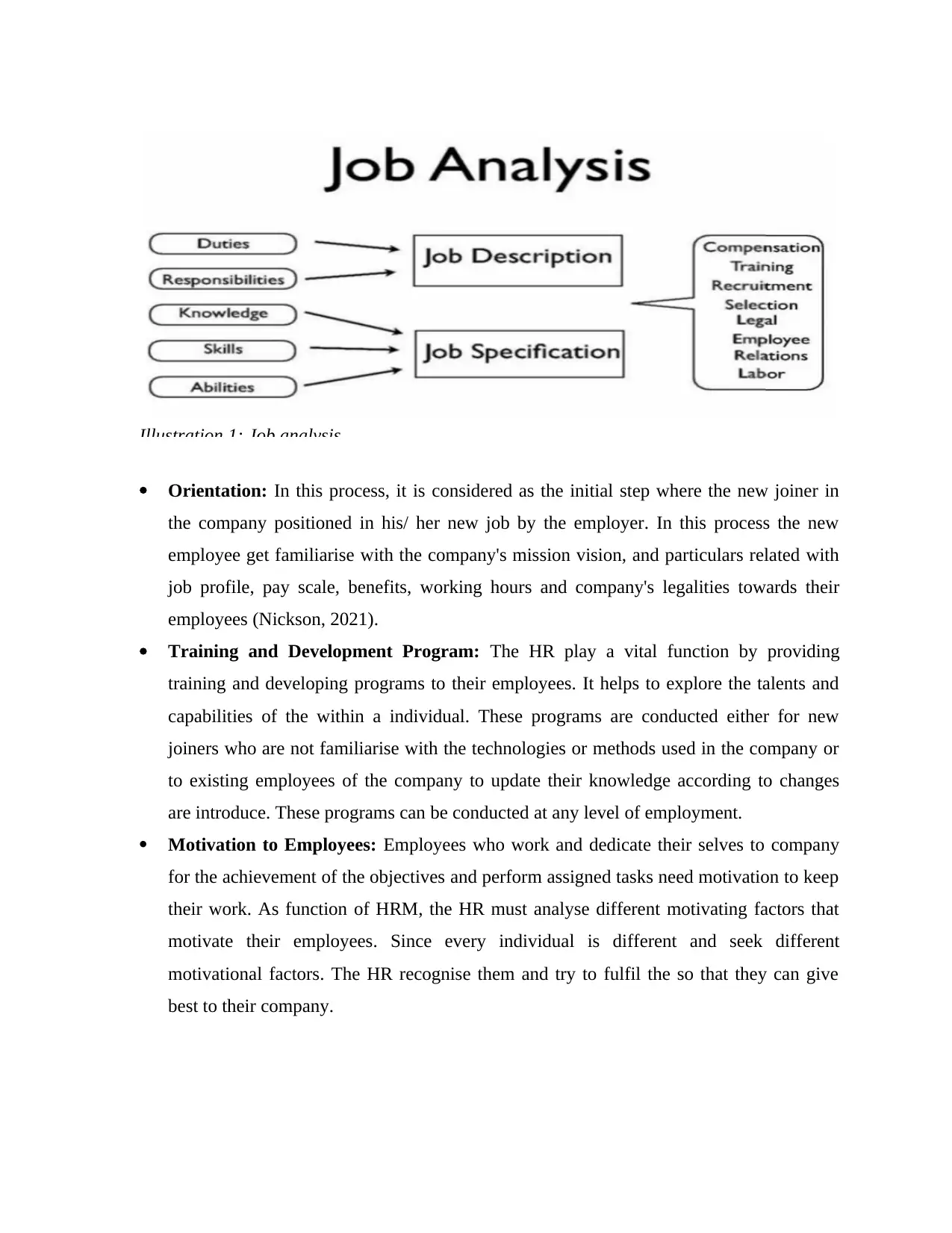
Orientation: In this process, it is considered as the initial step where the new joiner in
the company positioned in his/ her new job by the employer. In this process the new
employee get familiarise with the company's mission vision, and particulars related with
job profile, pay scale, benefits, working hours and company's legalities towards their
employees (Nickson, 2021).
Training and Development Program: The HR play a vital function by providing
training and developing programs to their employees. It helps to explore the talents and
capabilities of the within a individual. These programs are conducted either for new
joiners who are not familiarise with the technologies or methods used in the company or
to existing employees of the company to update their knowledge according to changes
are introduce. These programs can be conducted at any level of employment.
Motivation to Employees: Employees who work and dedicate their selves to company
for the achievement of the objectives and perform assigned tasks need motivation to keep
their work. As function of HRM, the HR must analyse different motivating factors that
motivate their employees. Since every individual is different and seek different
motivational factors. The HR recognise them and try to fulfil the so that they can give
best to their company.
Illustration 1: Job analysis
the company positioned in his/ her new job by the employer. In this process the new
employee get familiarise with the company's mission vision, and particulars related with
job profile, pay scale, benefits, working hours and company's legalities towards their
employees (Nickson, 2021).
Training and Development Program: The HR play a vital function by providing
training and developing programs to their employees. It helps to explore the talents and
capabilities of the within a individual. These programs are conducted either for new
joiners who are not familiarise with the technologies or methods used in the company or
to existing employees of the company to update their knowledge according to changes
are introduce. These programs can be conducted at any level of employment.
Motivation to Employees: Employees who work and dedicate their selves to company
for the achievement of the objectives and perform assigned tasks need motivation to keep
their work. As function of HRM, the HR must analyse different motivating factors that
motivate their employees. Since every individual is different and seek different
motivational factors. The HR recognise them and try to fulfil the so that they can give
best to their company.
Illustration 1: Job analysis
⊘ This is a preview!⊘
Do you want full access?
Subscribe today to unlock all pages.

Trusted by 1+ million students worldwide
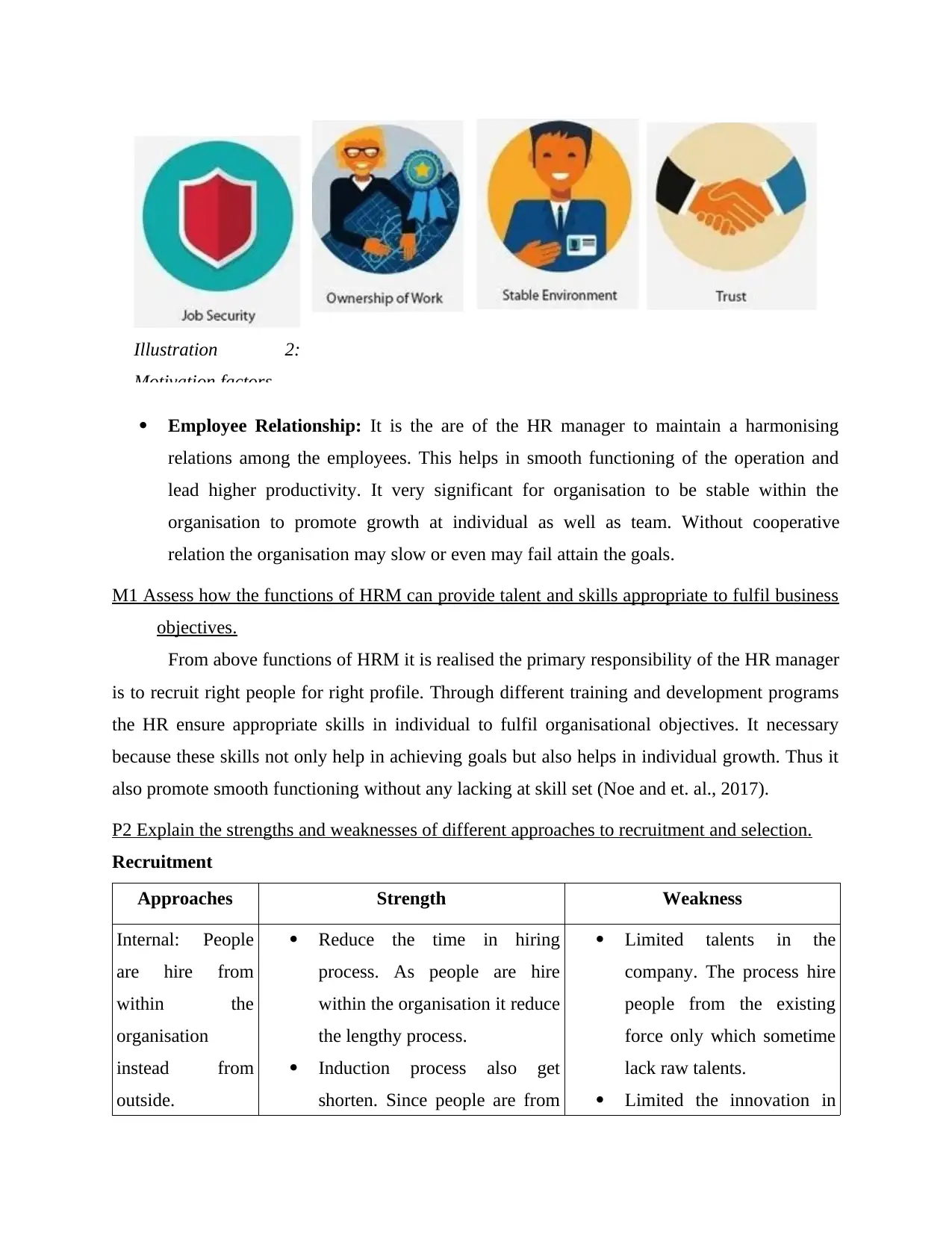
Employee Relationship: It is the are of the HR manager to maintain a harmonising
relations among the employees. This helps in smooth functioning of the operation and
lead higher productivity. It very significant for organisation to be stable within the
organisation to promote growth at individual as well as team. Without cooperative
relation the organisation may slow or even may fail attain the goals.
M1 Assess how the functions of HRM can provide talent and skills appropriate to fulfil business
objectives.
From above functions of HRM it is realised the primary responsibility of the HR manager
is to recruit right people for right profile. Through different training and development programs
the HR ensure appropriate skills in individual to fulfil organisational objectives. It necessary
because these skills not only help in achieving goals but also helps in individual growth. Thus it
also promote smooth functioning without any lacking at skill set (Noe and et. al., 2017).
P2 Explain the strengths and weaknesses of different approaches to recruitment and selection.
Recruitment
Approaches Strength Weakness
Internal: People
are hire from
within the
organisation
instead from
outside.
Reduce the time in hiring
process. As people are hire
within the organisation it reduce
the lengthy process.
Induction process also get
shorten. Since people are from
Limited talents in the
company. The process hire
people from the existing
force only which sometime
lack raw talents.
Limited the innovation in
Illustration 2:
Motivation factors
relations among the employees. This helps in smooth functioning of the operation and
lead higher productivity. It very significant for organisation to be stable within the
organisation to promote growth at individual as well as team. Without cooperative
relation the organisation may slow or even may fail attain the goals.
M1 Assess how the functions of HRM can provide talent and skills appropriate to fulfil business
objectives.
From above functions of HRM it is realised the primary responsibility of the HR manager
is to recruit right people for right profile. Through different training and development programs
the HR ensure appropriate skills in individual to fulfil organisational objectives. It necessary
because these skills not only help in achieving goals but also helps in individual growth. Thus it
also promote smooth functioning without any lacking at skill set (Noe and et. al., 2017).
P2 Explain the strengths and weaknesses of different approaches to recruitment and selection.
Recruitment
Approaches Strength Weakness
Internal: People
are hire from
within the
organisation
instead from
outside.
Reduce the time in hiring
process. As people are hire
within the organisation it reduce
the lengthy process.
Induction process also get
shorten. Since people are from
Limited talents in the
company. The process hire
people from the existing
force only which sometime
lack raw talents.
Limited the innovation in
Illustration 2:
Motivation factors
Paraphrase This Document
Need a fresh take? Get an instant paraphrase of this document with our AI Paraphraser
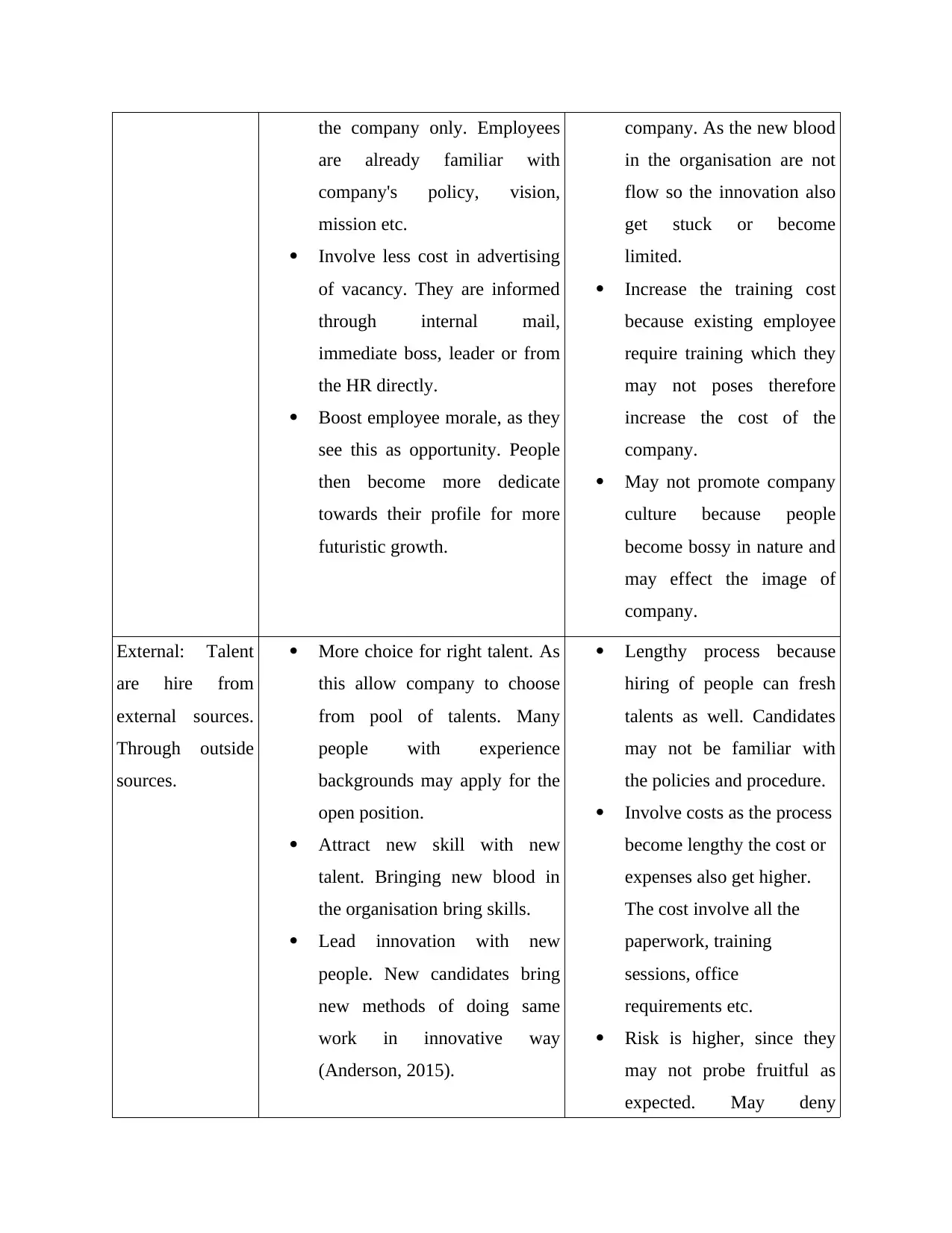
the company only. Employees
are already familiar with
company's policy, vision,
mission etc.
Involve less cost in advertising
of vacancy. They are informed
through internal mail,
immediate boss, leader or from
the HR directly.
Boost employee morale, as they
see this as opportunity. People
then become more dedicate
towards their profile for more
futuristic growth.
company. As the new blood
in the organisation are not
flow so the innovation also
get stuck or become
limited.
Increase the training cost
because existing employee
require training which they
may not poses therefore
increase the cost of the
company.
May not promote company
culture because people
become bossy in nature and
may effect the image of
company.
External: Talent
are hire from
external sources.
Through outside
sources.
More choice for right talent. As
this allow company to choose
from pool of talents. Many
people with experience
backgrounds may apply for the
open position.
Attract new skill with new
talent. Bringing new blood in
the organisation bring skills.
Lead innovation with new
people. New candidates bring
new methods of doing same
work in innovative way
(Anderson, 2015).
Lengthy process because
hiring of people can fresh
talents as well. Candidates
may not be familiar with
the policies and procedure.
Involve costs as the process
become lengthy the cost or
expenses also get higher.
The cost involve all the
paperwork, training
sessions, office
requirements etc.
Risk is higher, since they
may not probe fruitful as
expected. May deny
are already familiar with
company's policy, vision,
mission etc.
Involve less cost in advertising
of vacancy. They are informed
through internal mail,
immediate boss, leader or from
the HR directly.
Boost employee morale, as they
see this as opportunity. People
then become more dedicate
towards their profile for more
futuristic growth.
company. As the new blood
in the organisation are not
flow so the innovation also
get stuck or become
limited.
Increase the training cost
because existing employee
require training which they
may not poses therefore
increase the cost of the
company.
May not promote company
culture because people
become bossy in nature and
may effect the image of
company.
External: Talent
are hire from
external sources.
Through outside
sources.
More choice for right talent. As
this allow company to choose
from pool of talents. Many
people with experience
backgrounds may apply for the
open position.
Attract new skill with new
talent. Bringing new blood in
the organisation bring skills.
Lead innovation with new
people. New candidates bring
new methods of doing same
work in innovative way
(Anderson, 2015).
Lengthy process because
hiring of people can fresh
talents as well. Candidates
may not be familiar with
the policies and procedure.
Involve costs as the process
become lengthy the cost or
expenses also get higher.
The cost involve all the
paperwork, training
sessions, office
requirements etc.
Risk is higher, since they
may not probe fruitful as
expected. May deny
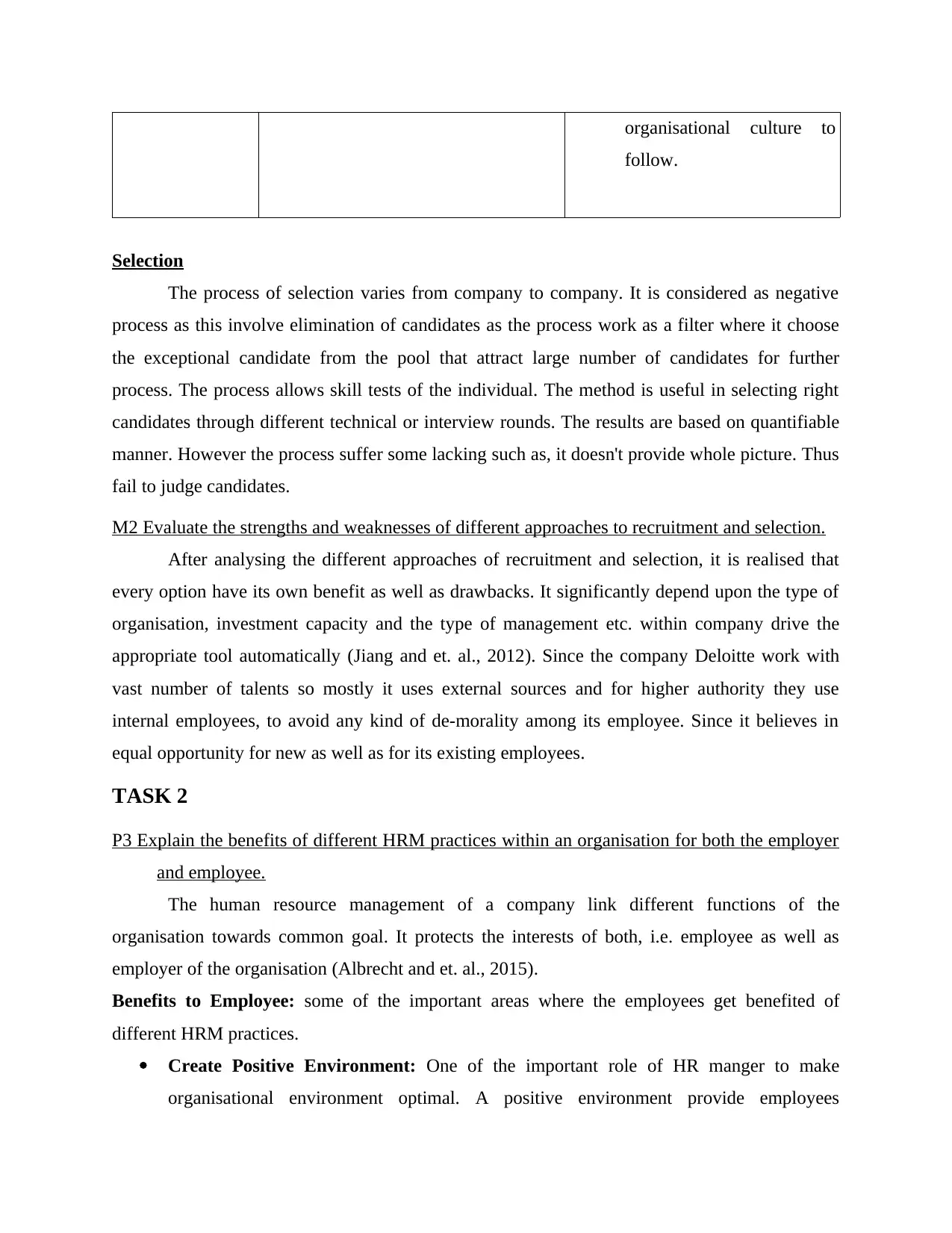
organisational culture to
follow.
Selection
The process of selection varies from company to company. It is considered as negative
process as this involve elimination of candidates as the process work as a filter where it choose
the exceptional candidate from the pool that attract large number of candidates for further
process. The process allows skill tests of the individual. The method is useful in selecting right
candidates through different technical or interview rounds. The results are based on quantifiable
manner. However the process suffer some lacking such as, it doesn't provide whole picture. Thus
fail to judge candidates.
M2 Evaluate the strengths and weaknesses of different approaches to recruitment and selection.
After analysing the different approaches of recruitment and selection, it is realised that
every option have its own benefit as well as drawbacks. It significantly depend upon the type of
organisation, investment capacity and the type of management etc. within company drive the
appropriate tool automatically (Jiang and et. al., 2012). Since the company Deloitte work with
vast number of talents so mostly it uses external sources and for higher authority they use
internal employees, to avoid any kind of de-morality among its employee. Since it believes in
equal opportunity for new as well as for its existing employees.
TASK 2
P3 Explain the benefits of different HRM practices within an organisation for both the employer
and employee.
The human resource management of a company link different functions of the
organisation towards common goal. It protects the interests of both, i.e. employee as well as
employer of the organisation (Albrecht and et. al., 2015).
Benefits to Employee: some of the important areas where the employees get benefited of
different HRM practices.
Create Positive Environment: One of the important role of HR manger to make
organisational environment optimal. A positive environment provide employees
follow.
Selection
The process of selection varies from company to company. It is considered as negative
process as this involve elimination of candidates as the process work as a filter where it choose
the exceptional candidate from the pool that attract large number of candidates for further
process. The process allows skill tests of the individual. The method is useful in selecting right
candidates through different technical or interview rounds. The results are based on quantifiable
manner. However the process suffer some lacking such as, it doesn't provide whole picture. Thus
fail to judge candidates.
M2 Evaluate the strengths and weaknesses of different approaches to recruitment and selection.
After analysing the different approaches of recruitment and selection, it is realised that
every option have its own benefit as well as drawbacks. It significantly depend upon the type of
organisation, investment capacity and the type of management etc. within company drive the
appropriate tool automatically (Jiang and et. al., 2012). Since the company Deloitte work with
vast number of talents so mostly it uses external sources and for higher authority they use
internal employees, to avoid any kind of de-morality among its employee. Since it believes in
equal opportunity for new as well as for its existing employees.
TASK 2
P3 Explain the benefits of different HRM practices within an organisation for both the employer
and employee.
The human resource management of a company link different functions of the
organisation towards common goal. It protects the interests of both, i.e. employee as well as
employer of the organisation (Albrecht and et. al., 2015).
Benefits to Employee: some of the important areas where the employees get benefited of
different HRM practices.
Create Positive Environment: One of the important role of HR manger to make
organisational environment optimal. A positive environment provide employees
⊘ This is a preview!⊘
Do you want full access?
Subscribe today to unlock all pages.

Trusted by 1+ million students worldwide
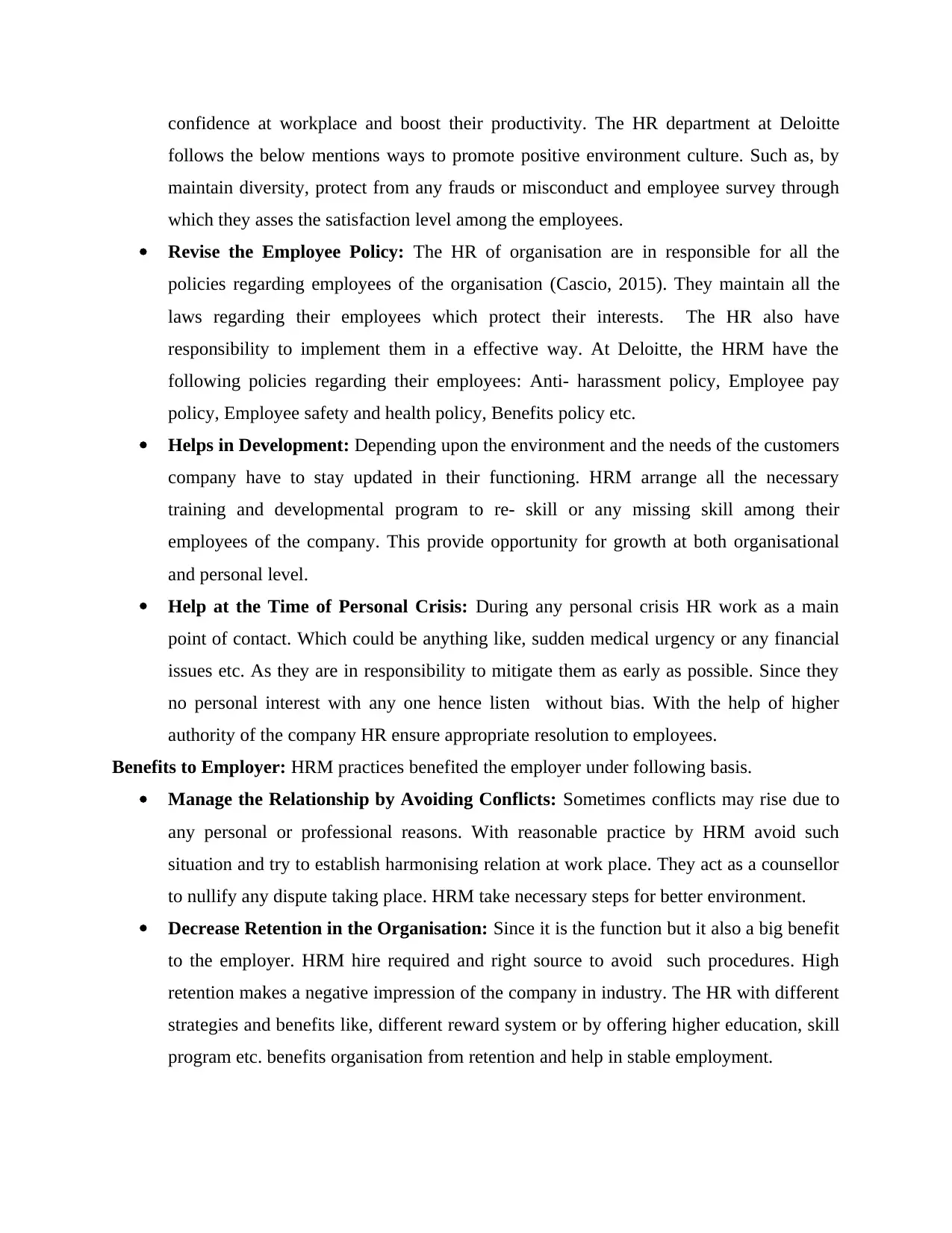
confidence at workplace and boost their productivity. The HR department at Deloitte
follows the below mentions ways to promote positive environment culture. Such as, by
maintain diversity, protect from any frauds or misconduct and employee survey through
which they asses the satisfaction level among the employees.
Revise the Employee Policy: The HR of organisation are in responsible for all the
policies regarding employees of the organisation (Cascio, 2015). They maintain all the
laws regarding their employees which protect their interests. The HR also have
responsibility to implement them in a effective way. At Deloitte, the HRM have the
following policies regarding their employees: Anti- harassment policy, Employee pay
policy, Employee safety and health policy, Benefits policy etc.
Helps in Development: Depending upon the environment and the needs of the customers
company have to stay updated in their functioning. HRM arrange all the necessary
training and developmental program to re- skill or any missing skill among their
employees of the company. This provide opportunity for growth at both organisational
and personal level.
Help at the Time of Personal Crisis: During any personal crisis HR work as a main
point of contact. Which could be anything like, sudden medical urgency or any financial
issues etc. As they are in responsibility to mitigate them as early as possible. Since they
no personal interest with any one hence listen without bias. With the help of higher
authority of the company HR ensure appropriate resolution to employees.
Benefits to Employer: HRM practices benefited the employer under following basis.
Manage the Relationship by Avoiding Conflicts: Sometimes conflicts may rise due to
any personal or professional reasons. With reasonable practice by HRM avoid such
situation and try to establish harmonising relation at work place. They act as a counsellor
to nullify any dispute taking place. HRM take necessary steps for better environment.
Decrease Retention in the Organisation: Since it is the function but it also a big benefit
to the employer. HRM hire required and right source to avoid such procedures. High
retention makes a negative impression of the company in industry. The HR with different
strategies and benefits like, different reward system or by offering higher education, skill
program etc. benefits organisation from retention and help in stable employment.
follows the below mentions ways to promote positive environment culture. Such as, by
maintain diversity, protect from any frauds or misconduct and employee survey through
which they asses the satisfaction level among the employees.
Revise the Employee Policy: The HR of organisation are in responsible for all the
policies regarding employees of the organisation (Cascio, 2015). They maintain all the
laws regarding their employees which protect their interests. The HR also have
responsibility to implement them in a effective way. At Deloitte, the HRM have the
following policies regarding their employees: Anti- harassment policy, Employee pay
policy, Employee safety and health policy, Benefits policy etc.
Helps in Development: Depending upon the environment and the needs of the customers
company have to stay updated in their functioning. HRM arrange all the necessary
training and developmental program to re- skill or any missing skill among their
employees of the company. This provide opportunity for growth at both organisational
and personal level.
Help at the Time of Personal Crisis: During any personal crisis HR work as a main
point of contact. Which could be anything like, sudden medical urgency or any financial
issues etc. As they are in responsibility to mitigate them as early as possible. Since they
no personal interest with any one hence listen without bias. With the help of higher
authority of the company HR ensure appropriate resolution to employees.
Benefits to Employer: HRM practices benefited the employer under following basis.
Manage the Relationship by Avoiding Conflicts: Sometimes conflicts may rise due to
any personal or professional reasons. With reasonable practice by HRM avoid such
situation and try to establish harmonising relation at work place. They act as a counsellor
to nullify any dispute taking place. HRM take necessary steps for better environment.
Decrease Retention in the Organisation: Since it is the function but it also a big benefit
to the employer. HRM hire required and right source to avoid such procedures. High
retention makes a negative impression of the company in industry. The HR with different
strategies and benefits like, different reward system or by offering higher education, skill
program etc. benefits organisation from retention and help in stable employment.
Paraphrase This Document
Need a fresh take? Get an instant paraphrase of this document with our AI Paraphraser
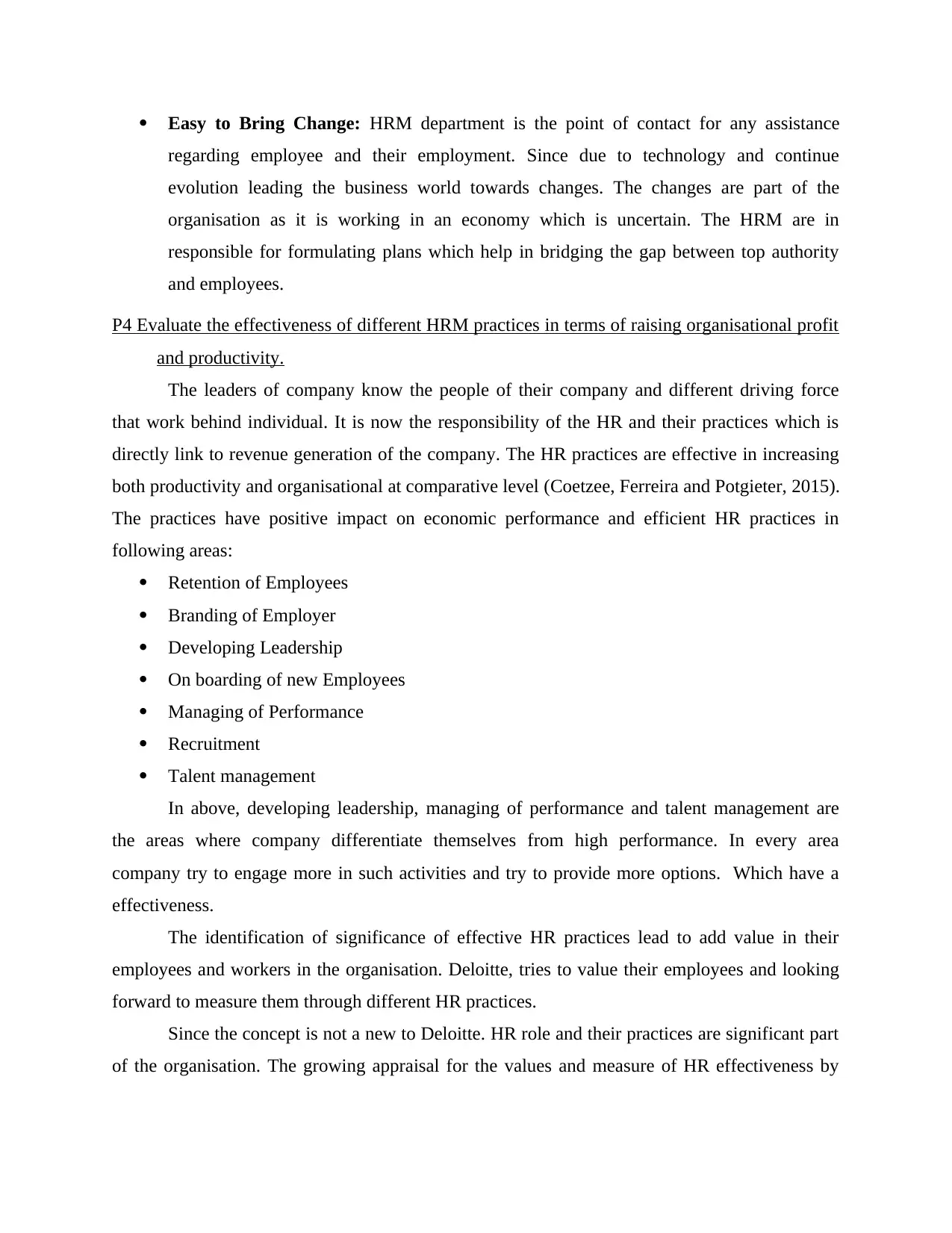
Easy to Bring Change: HRM department is the point of contact for any assistance
regarding employee and their employment. Since due to technology and continue
evolution leading the business world towards changes. The changes are part of the
organisation as it is working in an economy which is uncertain. The HRM are in
responsible for formulating plans which help in bridging the gap between top authority
and employees.
P4 Evaluate the effectiveness of different HRM practices in terms of raising organisational profit
and productivity.
The leaders of company know the people of their company and different driving force
that work behind individual. It is now the responsibility of the HR and their practices which is
directly link to revenue generation of the company. The HR practices are effective in increasing
both productivity and organisational at comparative level (Coetzee, Ferreira and Potgieter, 2015).
The practices have positive impact on economic performance and efficient HR practices in
following areas:
Retention of Employees
Branding of Employer
Developing Leadership
On boarding of new Employees
Managing of Performance
Recruitment
Talent management
In above, developing leadership, managing of performance and talent management are
the areas where company differentiate themselves from high performance. In every area
company try to engage more in such activities and try to provide more options. Which have a
effectiveness.
The identification of significance of effective HR practices lead to add value in their
employees and workers in the organisation. Deloitte, tries to value their employees and looking
forward to measure them through different HR practices.
Since the concept is not a new to Deloitte. HR role and their practices are significant part
of the organisation. The growing appraisal for the values and measure of HR effectiveness by
regarding employee and their employment. Since due to technology and continue
evolution leading the business world towards changes. The changes are part of the
organisation as it is working in an economy which is uncertain. The HRM are in
responsible for formulating plans which help in bridging the gap between top authority
and employees.
P4 Evaluate the effectiveness of different HRM practices in terms of raising organisational profit
and productivity.
The leaders of company know the people of their company and different driving force
that work behind individual. It is now the responsibility of the HR and their practices which is
directly link to revenue generation of the company. The HR practices are effective in increasing
both productivity and organisational at comparative level (Coetzee, Ferreira and Potgieter, 2015).
The practices have positive impact on economic performance and efficient HR practices in
following areas:
Retention of Employees
Branding of Employer
Developing Leadership
On boarding of new Employees
Managing of Performance
Recruitment
Talent management
In above, developing leadership, managing of performance and talent management are
the areas where company differentiate themselves from high performance. In every area
company try to engage more in such activities and try to provide more options. Which have a
effectiveness.
The identification of significance of effective HR practices lead to add value in their
employees and workers in the organisation. Deloitte, tries to value their employees and looking
forward to measure them through different HR practices.
Since the concept is not a new to Deloitte. HR role and their practices are significant part
of the organisation. The growing appraisal for the values and measure of HR effectiveness by
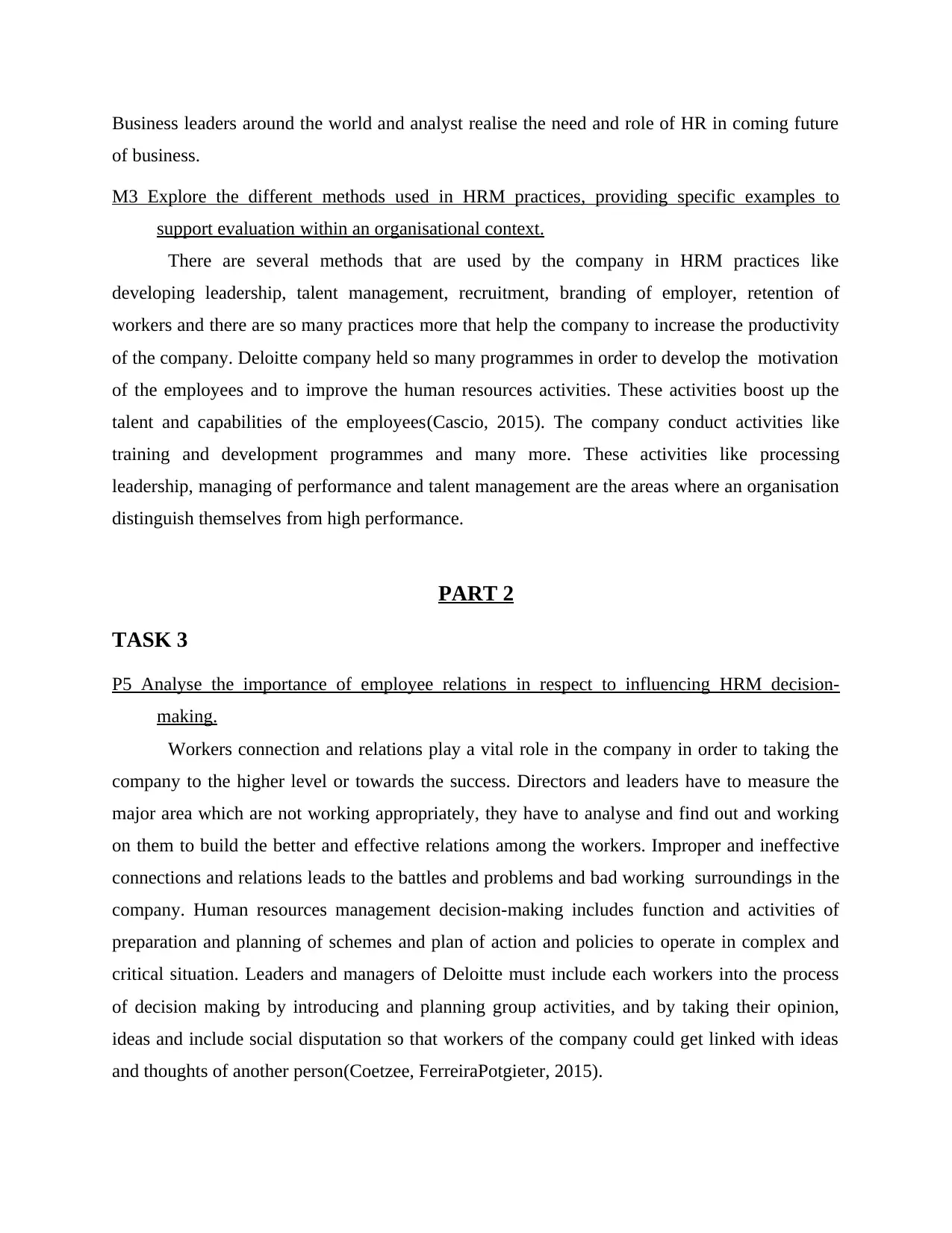
Business leaders around the world and analyst realise the need and role of HR in coming future
of business.
M3 Explore the different methods used in HRM practices, providing specific examples to
support evaluation within an organisational context.
There are several methods that are used by the company in HRM practices like
developing leadership, talent management, recruitment, branding of employer, retention of
workers and there are so many practices more that help the company to increase the productivity
of the company. Deloitte company held so many programmes in order to develop the motivation
of the employees and to improve the human resources activities. These activities boost up the
talent and capabilities of the employees(Cascio, 2015). The company conduct activities like
training and development programmes and many more. These activities like processing
leadership, managing of performance and talent management are the areas where an organisation
distinguish themselves from high performance.
PART 2
TASK 3
P5 Analyse the importance of employee relations in respect to influencing HRM decision-
making.
Workers connection and relations play a vital role in the company in order to taking the
company to the higher level or towards the success. Directors and leaders have to measure the
major area which are not working appropriately, they have to analyse and find out and working
on them to build the better and effective relations among the workers. Improper and ineffective
connections and relations leads to the battles and problems and bad working surroundings in the
company. Human resources management decision-making includes function and activities of
preparation and planning of schemes and plan of action and policies to operate in complex and
critical situation. Leaders and managers of Deloitte must include each workers into the process
of decision making by introducing and planning group activities, and by taking their opinion,
ideas and include social disputation so that workers of the company could get linked with ideas
and thoughts of another person(Coetzee, FerreiraPotgieter, 2015).
of business.
M3 Explore the different methods used in HRM practices, providing specific examples to
support evaluation within an organisational context.
There are several methods that are used by the company in HRM practices like
developing leadership, talent management, recruitment, branding of employer, retention of
workers and there are so many practices more that help the company to increase the productivity
of the company. Deloitte company held so many programmes in order to develop the motivation
of the employees and to improve the human resources activities. These activities boost up the
talent and capabilities of the employees(Cascio, 2015). The company conduct activities like
training and development programmes and many more. These activities like processing
leadership, managing of performance and talent management are the areas where an organisation
distinguish themselves from high performance.
PART 2
TASK 3
P5 Analyse the importance of employee relations in respect to influencing HRM decision-
making.
Workers connection and relations play a vital role in the company in order to taking the
company to the higher level or towards the success. Directors and leaders have to measure the
major area which are not working appropriately, they have to analyse and find out and working
on them to build the better and effective relations among the workers. Improper and ineffective
connections and relations leads to the battles and problems and bad working surroundings in the
company. Human resources management decision-making includes function and activities of
preparation and planning of schemes and plan of action and policies to operate in complex and
critical situation. Leaders and managers of Deloitte must include each workers into the process
of decision making by introducing and planning group activities, and by taking their opinion,
ideas and include social disputation so that workers of the company could get linked with ideas
and thoughts of another person(Coetzee, FerreiraPotgieter, 2015).
⊘ This is a preview!⊘
Do you want full access?
Subscribe today to unlock all pages.

Trusted by 1+ million students worldwide
1 out of 20
Related Documents
Your All-in-One AI-Powered Toolkit for Academic Success.
+13062052269
info@desklib.com
Available 24*7 on WhatsApp / Email
![[object Object]](/_next/static/media/star-bottom.7253800d.svg)
Unlock your academic potential
Copyright © 2020–2025 A2Z Services. All Rights Reserved. Developed and managed by ZUCOL.



